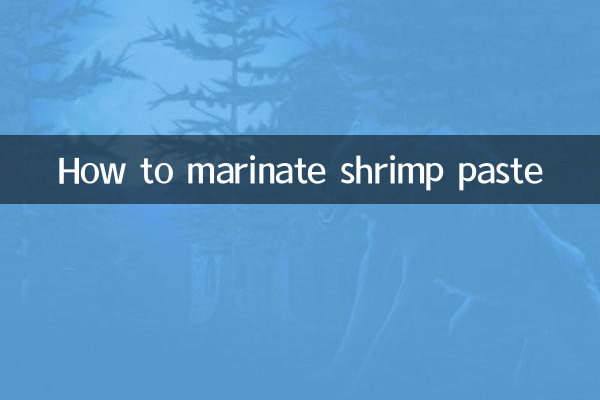How to marinate shrimp paste: a complete analysis of traditional techniques and modern methods
Shrimp paste is a unique condiment widely used in Asian cuisine, especially in Southeast Asia and coastal China. The method of making it varies by region and family tradition, but the core steps are generally the same. This article will combine the hot topics and hot content on the Internet in the past 10 days to give you a detailed introduction to the pickling method of shrimp paste, and attach relevant data comparisons.
1. Basic introduction to shrimp paste

Shrimp paste is a condiment made from shrimps or dried shrimps through fermentation and pickling. It has a salty and rich flavor and is often used in stir-fries, dips or stews. The following are common classifications of shrimp paste:
| type | raw material | fermentation time | Features |
|---|---|---|---|
| traditional shrimp paste | shrimp, salt | 3-6 months | Strong salty taste and rich fermentation aroma |
| Instant Shrimp Paste | Shrimp, salt, sugar | 1-2 weeks | The taste is lighter and suitable for modern fast pace |
| spicy shrimp paste | Shrimp, chili, salt | 2-3 months | Spicy, suitable for people with heavy tastes |
2. Marinating method of shrimp paste
1. Traditional shrimp paste pickling steps
(1)Select materials: Choose fresh shrimps or dried shrimps, wash them and drain them.
(2)With salt: Mix shrimp and salt in a ratio of 10:1 and stir evenly.
(3)fermentation: Put the mixture into a clean clay pot, seal it and place it in a cool place to ferment for 3-6 months.
(4)Stir: Stir every other week to ensure even fermentation.
(5)Finished product: After the fermentation is completed, the shrimp paste will turn dark red and have a fine texture and is ready to eat.
2. Modern instant shrimp paste recipe
(1)Raw material preparation: 500 grams of dried shrimps, 50 grams of salt, 20 grams of sugar, 10 ml of white wine.
(2)Grind: Grind the dried shrimps into a puree, add salt, sugar and white wine and mix well.
(3)sealed fermentation: Place in a sealed jar and refrigerate for 1-2 weeks before use.
3. Frequently Asked Questions about Shrimp Paste
Q1: What should I do if shrimp paste becomes moldy during fermentation?
A1: If there are slight mildew spots on the surface, you can scrape them off and continue fermentation; if the mildew is severe, it is recommended to discard them.
Q2: How long can shrimp paste be stored?
A2: Traditional shrimp paste can be stored for 1-2 years under sealed conditions, and instant shrimp paste is recommended to be consumed within 3 months.
Q3: How to adjust the saltiness of shrimp paste?
A3: The amount of salt can be reduced according to personal taste, but too little salt may lead to spoilage.
4. Suggestions for eating shrimp paste
Shrimp paste is versatile, and here are some popular ways to eat it:
| dish name | practice |
|---|---|
| Stir-fried water spinach with shrimp paste | Heat oil and sauté shrimp paste until fragrant, add water spinach and stir-fry |
| Steamed pork with shrimp paste | Slice pork, stir in shrimp paste and steam for 15 minutes |
| Shrimp paste dipping sauce | Shrimp paste is mixed with lemon juice and sugar and served with seafood |
5. Conclusion
Although making shrimp paste is simple, it requires patience and skill. Whether using traditional techniques or modern methods, you can make delicious shrimp paste. I hope this article can help you easily make unique shrimp paste at home!

check the details

check the details